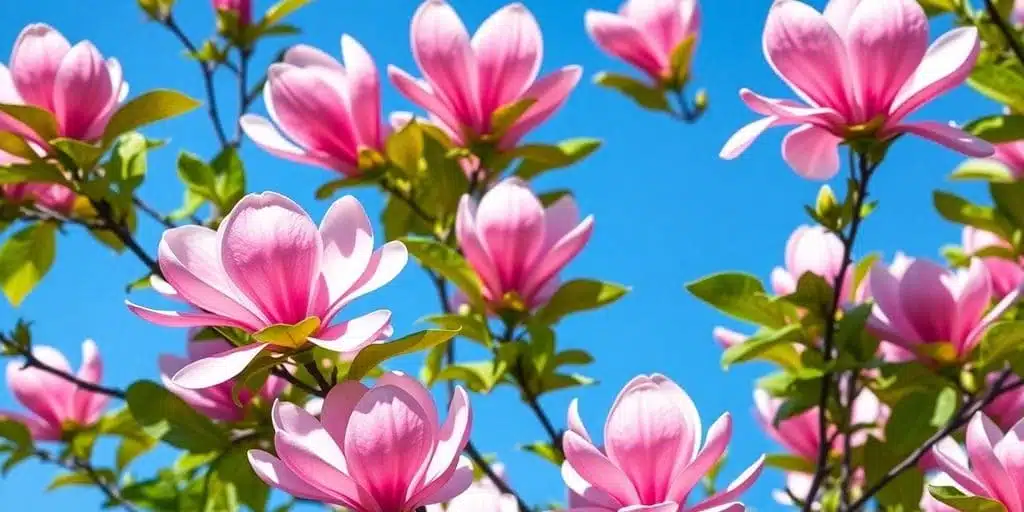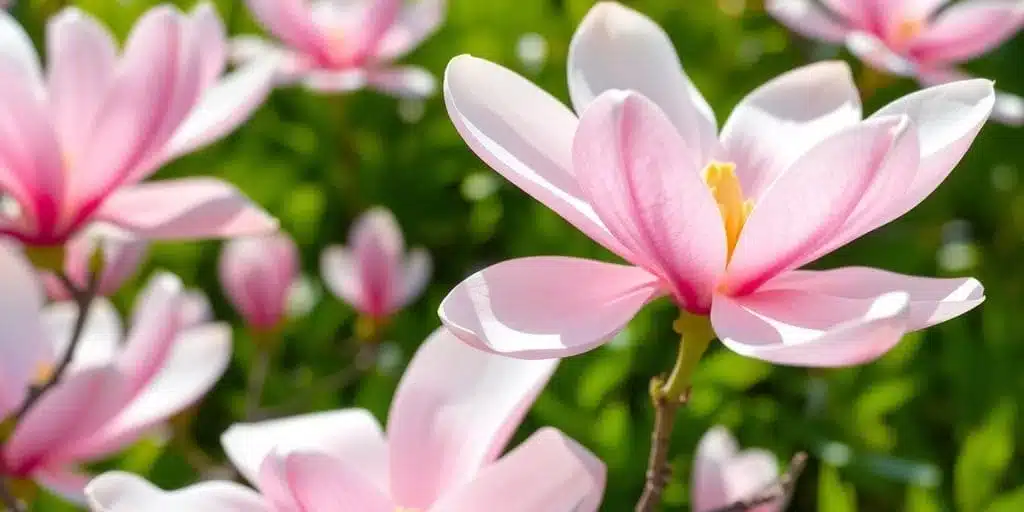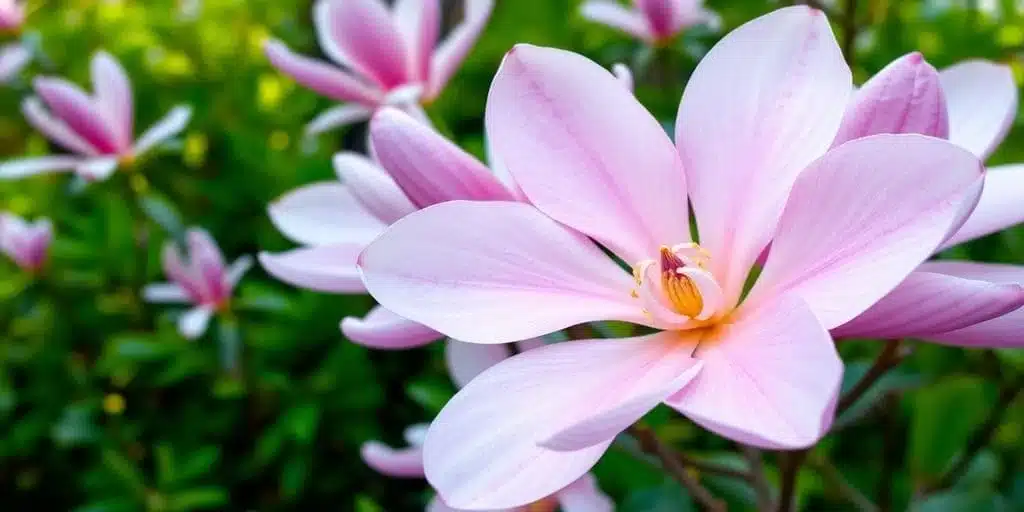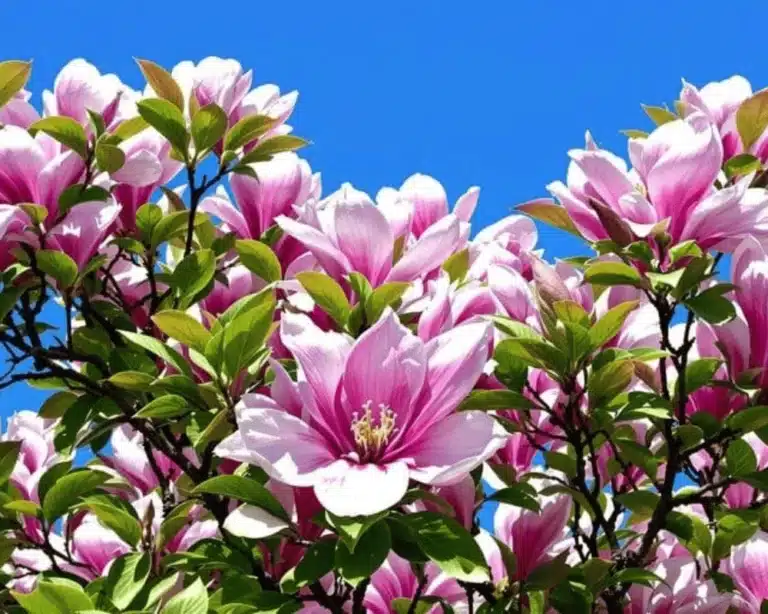Japanese Magnolia trees are a gardener’s delight, bringing a splash of elegance with their stunning blooms. Whether you’re an experienced gardener or just starting out, these trees can be a beautiful addition to any yard. With the right care and attention, they can thrive and become a focal point in your garden. In this article, we’ll explore how to plant, care for, and make the most of Japanese Magnolia in your garden.
Table of Contents
Understanding Japanese Magnolia Varieties
Japanese magnolia trees are a stunning addition to any garden, offering a range of beautiful varieties that cater to different tastes and garden needs. These elegant trees, known for their classic light, purplish-pink flowers, bring a touch of Japan’s serene beauty to your backyard.
Kobus Magnolia: A Classic Choice
Kobus Magnolia, or Magnolia kobus, is a favorite among Japanese magnolia varieties. Native to Japan, this medium-sized tree is known for its early spring blossoms. The flowers are goblet-shaped and slightly fragrant, with a delicate white hue tinged with pink. Kobus Magnolia is perfect for those who appreciate a classic and timeless look in their garden. This tree thrives in moist, well-drained soil and can tolerate a range of light exposures, from full sun to partial shade.
Magnolia Liliiflora: The Mulan Magnolia
Magnolia Liliiflora, often called the Mulan Magnolia, stands out with its striking purple magnolia flowers. This variety is a bit more compact, making it suitable for smaller gardens or as a decorative shrub. The Mulan Magnolia blooms later in spring, offering a vibrant display of color when most other trees have finished flowering. It’s a hardy choice, adaptable to various soil types and conditions, ensuring it can flourish in many different environments.
Magnolia Stellata: The Star Magnolia
The Star Magnolia, or Magnolia Stellata, captivates with its star-shaped, fragrant white or pink flowers. This variety is ideal for those seeking a smaller, yet equally elegant tree. Typically growing up to 15 feet tall, the Star Magnolia is perfect for small spaces or as a focal point in a garden. It blooms in early spring, adding a burst of color and fragrance to your landscape. With its deciduous green leaves, this tree offers year-round interest, even when not in bloom.
Japanese magnolias are more than just beautiful trees; they are a testament to nature’s artistry, providing a unique blend of elegance and resilience. Whether you’re drawn to the classic charm of the Kobus Magnolia or the vivid hues of the Mulan, there’s a Japanese magnolia variety to suit every garden lover’s dream.
The Japanese Magnolia is not only a breathtaking ornamental tree but also pairs beautifully with shrubs to create a dynamic and visually appealing garden landscape. Its vibrant blooms and elegant form make it a standout choice. If you’d like to discover other types of ornamental trees to enhance your garden, check out our article.
Planting Japanese Magnolia: Best Practices

Choosing the Right Location
When it comes to planting a Japanese Magnolia, picking the perfect spot is vital. These trees thrive in a sunny location, soaking up at least six hours of sunlight daily. However, they can handle a bit of shade too. Just make sure they aren’t stuck in a spot that’s too dark. Also, keep in mind their size when they mature—around 30 to 40 feet tall and wide—so avoid planting them too close to buildings or other trees.
Preparing the Soil for Planting
Soil preparation is another key step. Japanese Magnolias prefer well-drained soil. If your garden tends to have wet soil, you might want to consider raising the planting area to improve drainage. Before planting, test the soil moisture and ensure it’s not too soggy, as these trees don’t like their roots sitting in water. Adding some organic compost can also help boost the soil’s quality, providing essential nutrients for the tree.
Planting Techniques for Success
Now, let’s talk about getting that magnolia in the ground. Dig a hole that’s about twice as wide as the root ball. This gives the roots plenty of space to spread out. Make sure the root flare—the part where the trunk starts to widen—is visible at ground level. This prevents soil from covering it, which could cause issues down the line. Once planted, backfill with soil, gently packing it around the roots. Water thoroughly to settle the soil and eliminate air pockets. Remember, magnolias appreciate consistent moisture but hate standing water.
Planting your Japanese Magnolia correctly from the start sets the tone for a healthy, blooming tree. It’s all about the right location, proper soil, and careful planting. With these steps, your magnolia will be well on its way to becoming a stunning addition to your garden.
Caring for Your Japanese Magnolia

Watering Needs and Techniques
Japanese Magnolias, being deciduous trees, have specific watering needs that change with the seasons. In the early stages, especially when newly planted, these trees require regular watering to help establish their roots. Once established, they are relatively drought-tolerant, but during dry spells, it’s beneficial to provide supplemental watering. Always water deeply and infrequently to encourage deep root growth. Monitor the soil moisture and adjust your watering schedule based on the tree’s health and weather conditions.
Pruning for Health and Shape
Pruning is essential for maintaining the health and shape of your Japanese Magnolia. The best time to prune is late winter or early spring before new growth begins. Focus on removing dead or diseased branches and any that are crossing or rubbing against each other. This not only improves the tree’s appearance but also allows for better air circulation and sunlight penetration. Be cautious not to over-prune as this can stress the tree and reduce flowering.
Dealing with Pests and Diseases
While Japanese Magnolias are generally hardy, they can fall victim to pests like scale insects or diseases such as leaf spot. Regular inspection is key. If you notice any signs of infestation or disease, act promptly. Use insecticidal soap for minor pest issues, and ensure good airflow around the tree by keeping the area clean of debris. For disease prevention, avoid overhead watering and ensure proper spacing between trees to reduce humidity levels. If problems persist, consult a local gardening expert for advice on treatment options.
“A well-cared-for Japanese Magnolia not only enhances the beauty of your garden but also contributes to a healthier ecosystem by supporting local wildlife.”
Fertilizing Japanese Magnolia for Optimal Growth

Understanding NPK Ratios
When it comes to fertilizing Japanese Magnolias, understanding NPK ratios is crucial. These ratios, which stand for nitrogen (N), phosphorus (P), and potassium (K), are vital for plant health. Think of nitrogen as the fuel for lush, green foliage, phosphorus as the key to vibrant blooms, and potassium as the plant’s immune booster. For Japanese Magnolias, a balanced 4-3-4 NPK ratio is often recommended. This ensures your tree gets the right nutrients to thrive. Regular soil tests can help determine what your specific soil needs, ensuring you don’t overdo any particular nutrient.
If you’d like to learn more about NPK ratios and how they impact plant growth, check out this detailed guide from the University of Minnesota Extension.
Organic vs. Synthetic Fertilizers
Deciding between organic and synthetic fertilizers can be a bit of a puzzle. Organic options, like compost or fish emulsion, release nutrients slowly, which is great for maintaining rich soil and keeping the soil moist. They also improve soil structure over time. However, if your magnolia is in dire need of nutrients, synthetic fertilizers might be the quicker fix. These provide a fast, concentrated nutrient boost but can lead to problems if overused, especially in alkaline soils.
Timing and Application Methods
Timing your fertilizer application is just as important as choosing the right type. Early spring is ideal, just as your magnolia starts to wake from its winter slumber. This is when the roots are most eager to soak up nutrients. A second application in early summer can support the tree’s active growth phase. Avoid fertilizing in late summer or fall, as this can encourage new growth that’s vulnerable to winter damage.
When applying fertilizer, sprinkle it evenly around the tree, starting about a foot from the trunk and extending past the drip line. Watering it in helps the nutrients reach the roots more effectively. Remember, it’s all about balance—too much fertilizer can be just as harmful as too little.
Fertilizing your Japanese Magnolia isn’t just about feeding the plant; it’s about nurturing the entire ecosystem in your garden. With the right approach, your magnolia will not only flourish but also contribute to a healthier, more vibrant garden environment, attracting pollinators and enhancing your outdoor space.
Benefits of Japanese Magnolia in Your Garden
Attracting Wildlife and Pollinators
Japanese Magnolias are not just beautiful trees; they are a magnet for wildlife. These attractive trees with their large, fragrant flowers are a haven for pollinators like bees and butterflies. The vibrant blossoms provide nectar and pollen, making them a crucial part of your garden’s ecosystem. Additionally, the seeds produced in late fall attract birds, adding another layer of life to your garden.
Enhancing Garden Aesthetics
The sheer beauty of Japanese Magnolias makes them a standout feature in any garden. Their attractive flowers, ranging from white to pink, create a stunning visual display. When in full bloom, these trees can transform a simple garden into a breathtaking landscape. Pairing Japanese Magnolias with well-chosen shrubs adds depth and texture, enhancing the overall aesthetic appeal. Their unique shape and seasonal interest, combined with the lush greenery of surrounding shrubs, make them a perfect choice for enhancing garden aesthetics, providing a focal point that draws the eye and invites admiration.
Environmental Benefits of Planting
Beyond their beauty, Japanese Magnolias offer several environmental benefits. They help improve air quality by absorbing pollutants and releasing oxygen. Their root systems can aid in soil stabilization, reducing erosion and promoting healthy soil. Moreover, by attracting pollinators, they play a part in supporting the local ecosystem, making your garden not just a place of beauty but also a hub of ecological activity.
Planting Japanese Magnolias means more than just adding beauty to your garden; it’s about creating a thriving, balanced ecosystem. These trees are a testament to how nature’s elegance can coexist with ecological benefits, making your garden a more vibrant and sustainable space.
Common Mistakes to Avoid with Japanese Magnolia
Over-Fertilization and Its Signs
Over-fertilizing your Japanese Magnolia can lead to several issues. Watch out for leaf burn, yellowing leaves, or a white crust forming on the soil. These are telltale signs that your tree is getting too much of a good thing. If you notice these symptoms, it’s time to reassess your fertilizing routine. To prevent over-fertilization, consider performing regular soil tests and stick to the recommended dosages.
Improper Planting Distances
Japanese Magnolias need space to grow and thrive. Planting them too close to other plants or structures like sheds or fences can stunt their growth. Ensure that your magnolia is planted at least 20 feet away from your house or any other large structure. This distance allows for proper root expansion and air circulation.
Ignoring Seasonal Care Needs
Each season brings unique care requirements for your Japanese Magnolia. During dry weather, it’s crucial to maintain consistent watering to prevent stress on the plant. In spring, adding mulch can help retain moisture and improve soil quality. Regular pruning is also necessary to maintain the tree’s shape and health. Neglecting these seasonal tasks can lead to a less vibrant and healthy tree.
Remember, a little attention to detail goes a long way in ensuring your Japanese Magnolia remains a stunning feature in your garden. Avoid these common pitfalls, and your tree will reward you with beautiful blooms year after year.
Wrapping Up Your Japanese Magnolia Journey
So, there you have it. Japanese Magnolias can be a stunning addition to any garden, offering beauty and a touch of elegance. With the right care, these trees can thrive and become a focal point in your outdoor space. Remember, it’s all about balance—give them the right amount of sunlight, water, and nutrients, and they’ll reward you with their gorgeous blooms. Keep an eye on their needs, especially during the changing seasons, and don’t be afraid to adjust your care routine as needed. Whether you’re a seasoned gardener or just starting out, growing a Japanese Magnolia can be a rewarding experience. Happy gardening!
Frequently Asked Questions
What is the best time to plant a Japanese Magnolia?
The best time to plant a Japanese Magnolia is in the early spring or fall when the weather is cool and the tree is not actively growing.
How much water does a Japanese Magnolia need?
Japanese Magnolias need regular watering, especially in dry periods. It’s important to keep the soil moist but not soggy.
Can Japanese Magnolias grow in pots?
Yes, Japanese Magnolias can be grown in pots, but they will need a large container and regular watering and feeding.
Do Japanese Magnolias attract wildlife?
Yes, Japanese Magnolias can attract birds and pollinators with their beautiful flowers and seeds.
What should I do if my Japanese Magnolia has yellow leaves?
Yellow leaves can be a sign of overwatering or poor drainage. Check the soil and adjust your watering schedule as needed.
How can I protect my Japanese Magnolia from pests?
Regularly inspect your tree for signs of pests and use appropriate treatments like insecticidal soap or neem oil if needed.


3 thoughts on “Japanese Magnolia Care: Best Tips for Stunning Results”